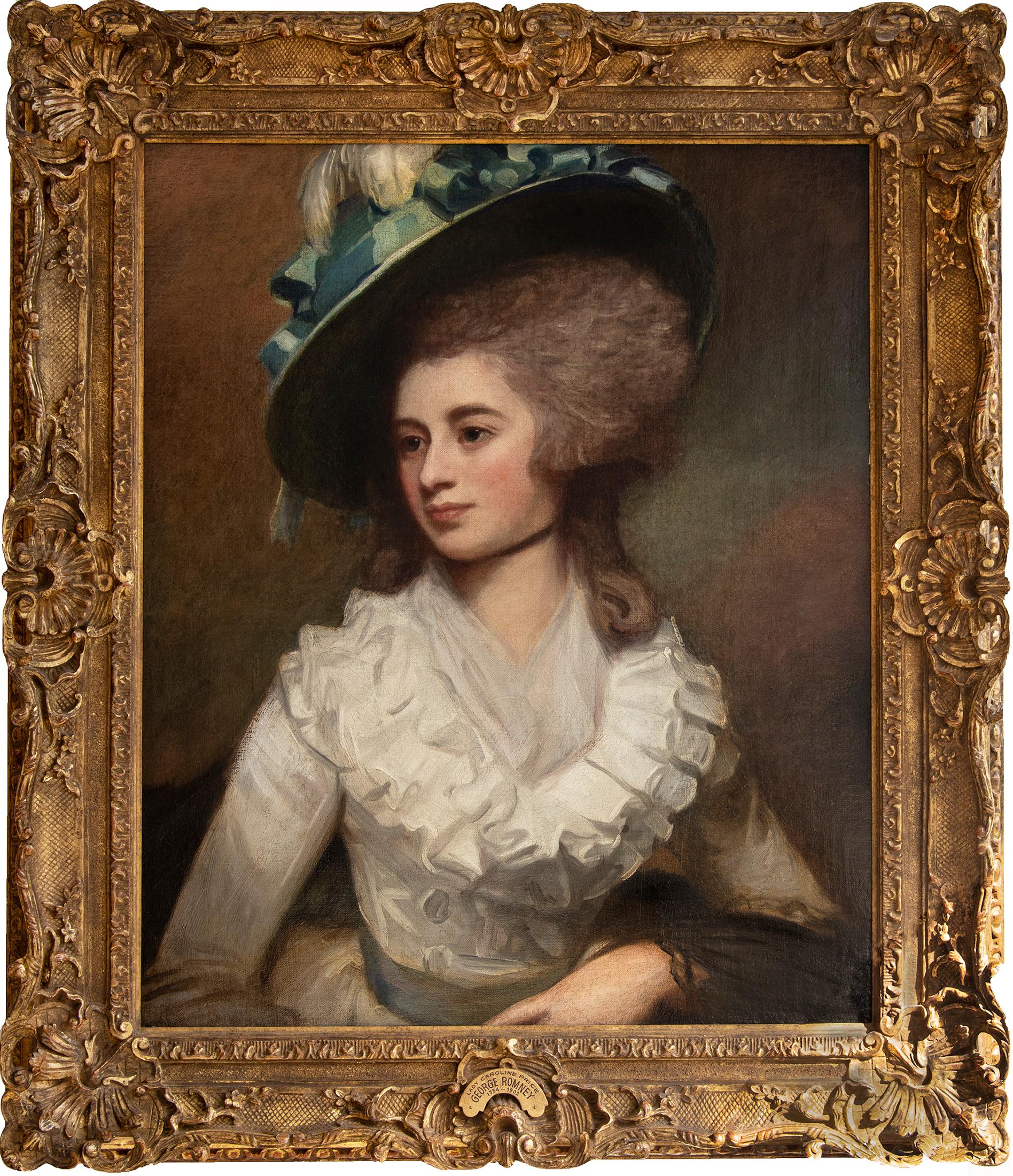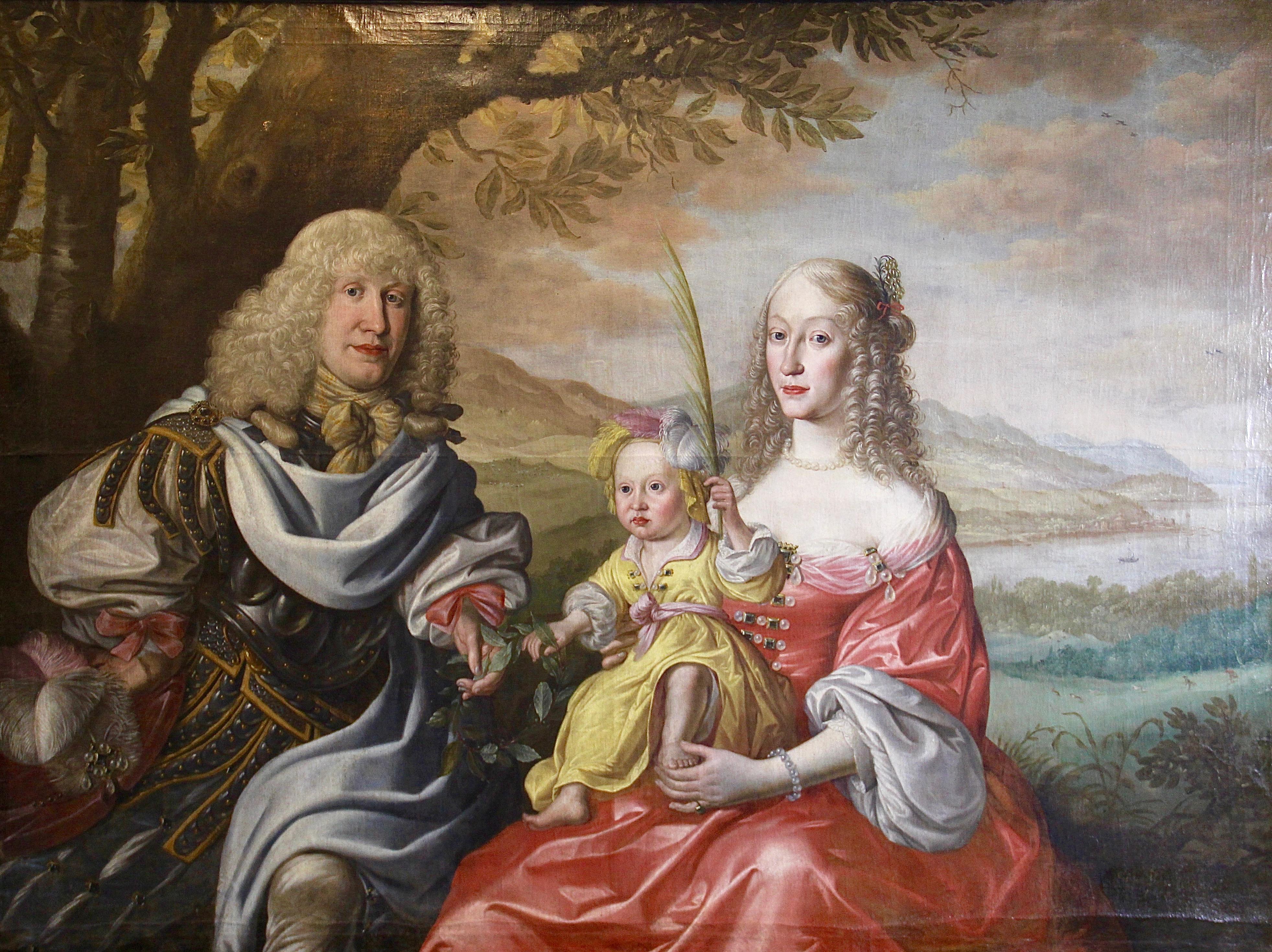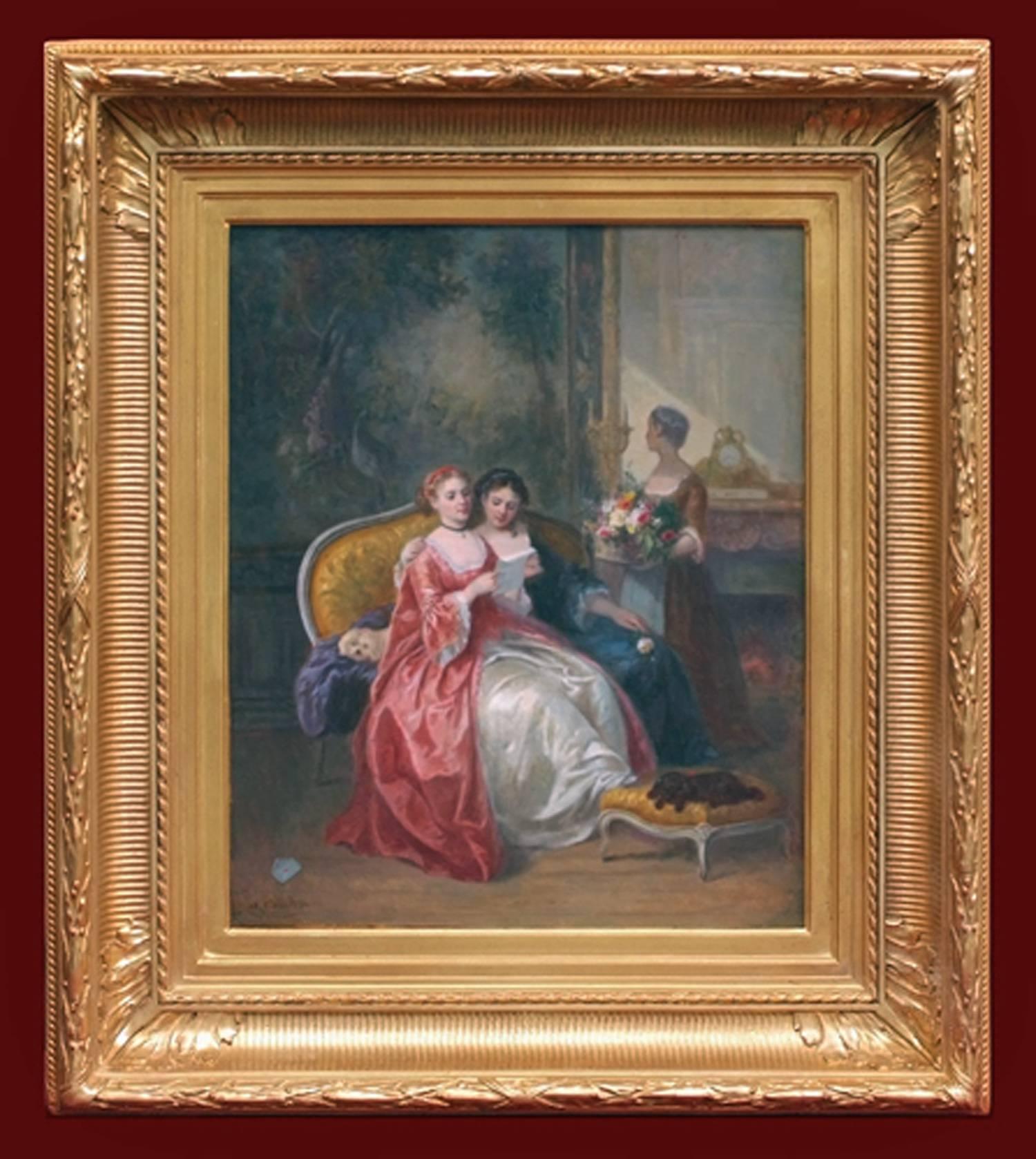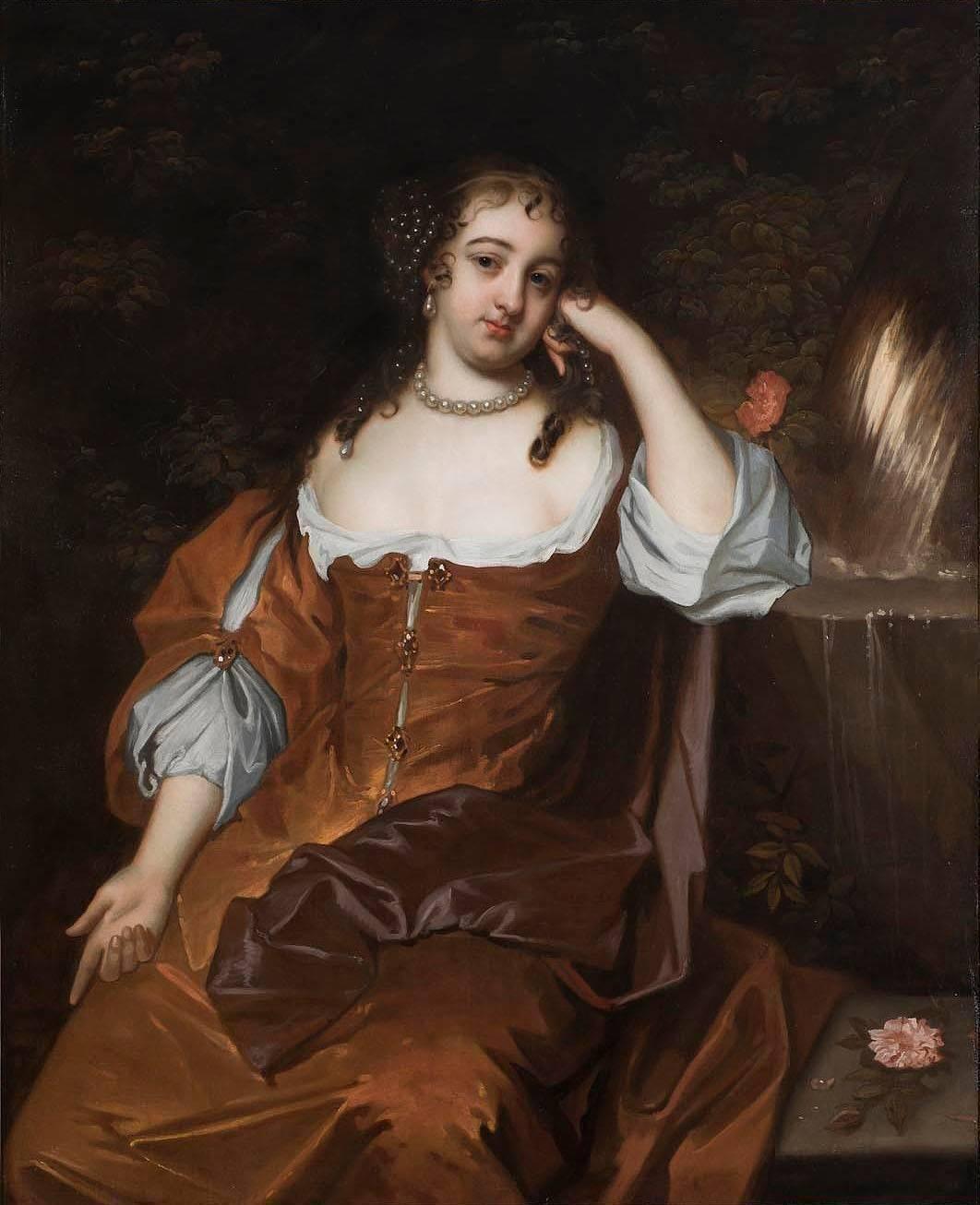Items Similar to 17th century portrait of Lady Sarah Cowper, Circle of Michael Dahl
Want more images or videos?
Request additional images or videos from the seller
1 of 6
17th century portrait of Lady Sarah Cowper, Circle of Michael Dahl17th century
17th century
About the Item
Portrait of Lady Sarah Cowper, nee Holled [1644-1720]-Circle of Michael Dahl 17th century,
oval,bust-length . She has dark hair tied high and wearing a brown silk dress with cream fringe and blue shawl
The size being 73 x 60 cm, (24 x 28.5 inches approx )the overall size 96.5 x 84 cm (38x33 inches approx)
housed in carved giltwood lely style frame.
Sarah,daughter of Samuel Holled, married Sir William Cowper, pronounced "cooper" Baronet of Ratling Court and Hertford Castle.
They had a son who became
William Cowper, 1st Earl Cowper PC KC FRS (c. 1665 – 10 October 1723) an English politician
who became the first Lord Chancellor of Great Britain.
Provenance. Inherited through ten generations of the Cowper family.
overall condition is very good having had some restoration,with old lining. Frame some minor losses which have been colour blended
The companion portrait of William Cowper is also available for sale at this time, please see my listings.
Michael Dahl (1659–1743)
A Swedish portrait painter who lived and worked in England most of his career.
He painted portraits of many aristocrats and some members of royal families.
His paintings are on show in many museums and national trust houses.
please email if you require any further information
Free UK delivery usually within 14 working days (courier gives time slot and date near to delivery day)
We ship worldwide for free( all taxes/customs etc to be paid for by customer)
- Creation Year:17th century
- Dimensions:Height: 38 in (96.5 cm)Diameter: 33.08 in (84 cm)
- Medium:
- Movement & Style:
- Circle Of:(Circle of) Michael Dahl (1659 - 1743, Swedish)
- Period:
- Condition:
- Gallery Location:York, GB
- Reference Number:1stDibs: LU180029762132
About the Seller
5.0
Vetted Seller
These experienced sellers undergo a comprehensive evaluation by our team of in-house experts.
Established in 1991
1stDibs seller since 2022
13 sales on 1stDibs
Typical response time: 8 hours
- ShippingRetrieving quote...Ships From: York, United Kingdom
- Return PolicyA return for this item may be initiated within 2 days of delivery.
More From This SellerView All
- large 18th century portrait gentleman oil on canvasLocated in York, GBA fine, imposing 18th century portrait of an unknown aristocrat,housed in a gilt frame The artist is also unidentified but certainly a talented hand, in the circle of one of the fine old masters of the period The size overall is 148 x 121 cm whilst the painting is 128 x 101 cm In overall good condition the frame at the bottom has bowed slightly The painting has been checked whilst being cleaned and has not been affected in any way . SHIPPING Free delivery to mainland uk ,worldwide shipping available please email for quote Delivery usually within 14 working days, insured please provide telephone/email details for courier. All taxes/customs etc to be paid for by purchaser. RETURNS (The Consumer Contracts Regulations) Whilst we are sure that you will be extremely happy with your purchase, if for any reason you are not, then you are entitled to return the item to us for a refund. For all purchases made you are entitled to return the item(s) for a period of up to 14 days following receipt by you or a representative indicated by you. Please contact us to confirm that you are returning the item(s) and the reason for doing so. Upon receipt of the item(s) we will refund the purchase price via your original payment method...Category
18th Century Old Masters Portrait Paintings
MaterialsOil
- 19th century antique portrait lady in landscape Godfrey Kneller (manner of)Located in York, GBFine Portrait of a lady standing in a landscape wearing a white satin dress and holding a posy of flowers. Manner of Sir Godfrey Kneller (1646-1723) ...Category
19th Century Old Masters Portrait Paintings
MaterialsOil
- Joseph Highmore Portrait of a lady, 18th centuryBy Joseph HighmoreLocated in York, GBPortrait of a lady, traditionally identified as Grace Loftus,of Beverley hall yorkshire.Three-quarter-length, before a window. Dressed in blue and wearing a white bonnet. The paintin...Category
1740s Old Masters Portrait Paintings
MaterialsOil
- Portrait Of A Gentleman John Dalziel KenworthyLocated in York, GBJohn Dalziel Kenworthy portrait of a gentleman . Fine, large and imposing oil on canvas housed in a gilt frame. The sitter is unidentified, he has an aristocratic and characterful lo...Category
Early 1900s Old Masters Portrait Paintings
MaterialsOil
- 19th Century Portrait Of A Young Woman Oil On CanvasLocated in York, GBFine 19th Century Oil on Canvas Portrait of a Young Woman in large gilt gesso frame Identity of the sitter as yet unknown. The artist has managed to capture her ethereal beauty perfe...Category
19th Century Old Masters Portrait Paintings
MaterialsOil
- 17th/18th century portrait , Circle Godfrey Kneller, wife, Earl of westmorlandBy (Circle of) Godfrey KnellerLocated in York, GBPortrait Circle of Sir Godfrey Kneller Bt. (British, 1646-1723) of Katharine, wife of Thomas, 6th Earl of Westmorland, oil on canvas late 17th early 18th century in date. The sitter Katharine is facing dexter and is wearing a cream dress, blue and gold cloak and lace mantilla...Category
18th Century Old Masters Portrait Paintings
MaterialsOil
You May Also Like
- Portrait of Gentleman, Thomas Bruce, Earl of Elgin c.1638 Manor House ProvenanceLocated in London, GBTitan Fine Art present this picture which formed part of a historic collection of an English aristocratic family, Lord and Lady Sandys at their magnificent baroque and Regency Grade-I listed family home, Ombersley Court. The house was among the most fascinating survivals of its kind in this country. The atmospheric interiors were distinguished above all for the works of art associated with two key moments in national history and, more specifically, to the roles of Colonel the Hon. John Russell in the Civil War and the reign of King Charles II and of Lord Arthur Hill, later 2nd Baron Sandys, in the Peninsular War. The collection was acquired or commissioned over five centuries and remained at Ombersley Court until its recent sale, the first in 294 years. This painting hung in The Great Hall (see photo). This charming portrait is an example of the type of small-scale panel portraits, often of splendid beauties of the time, that became fashionable from about the first quarter of the seventeenth century. The sitter has been depicted wearing a low-cut silk dress with the wide billowing sleeves typical of the late 1630’s. The simplicity of the ensemble is reinforced by the absence of lace on either the collar or cuffs. At this time gone are the complicated layers of fabrics, and now replaced with understated elegance of plain silk (satin and taffeta were most popular), with only a couple of focal points as accessories. There is an abundance of the accessory par excellence – pearls, and they are worn as a necklace, on her attire, and as earrings; the pear-shaped earrings are called ‘unions excellence’ reflecting the difficulty of finding perfectly matched pearls of such large size. They could range up to 20 millimetres in diameter. There is a splendid display of gold, diamond and pearl jewellery which is an obvious sign of her wealth. The portrait is thought to represent Thomas Bruce (1596-1654), Earl of Elgin. The physiognomy and features in our portrait strongly correlate to a portrait of the Earl, by Cornelius Johnson (1593-1661), painted circa 1638, and is held at Kenwood House, London. Another painting from Ombersley Court, also with Titan Fine Art, is contemporaneous to ours and is thought to represent the Earl’s wife, Diana Cecil, 1st Countess of Elgin (c.1603-1654) - it appears to have derived from Cornelius Johnson’s depiction of the Countess circa 1638, also at Kenwood House. During the 1630’s Johnson painted a number of portraits, obviously influenced by Van Dyke. Here, Theodore Russel, who worked in the studios of both Van Dyle and Johnson, and later specialised in small scale reproductions of his master’s works, modelled the head, with the striking large dark eyes, on Cornelius Johnson, and the attire on Anthony van Dyke. There are also other portraits by Johnson of the sitter with very similar facial features to that of the sitter in ours. Theodore Russel and Cornelius Johnson also had a family connection as it is thought that Russel’s step-mother was a sister of Johnson. Thomas Bruce, 1st Earl of Elgin, was a prominent Scottish nobleman who held titles such as the 3rd Lord Bruce of Kinloss. He resided at Houghton House in Bedfordshire and played a significant role in the political and social landscape of his time. His legacy as an Earl and Lord continues to be remembered in history. Thomas Bruce, born in Edinburgh in 1599, inherited the Scottish peerage title as the 3rd Lord Bruce of Kinloss at the age of 13 following his brother's untimely death in a duel. The family's estates, including Whorlton Castle and manor, were granted by King James I of England to Thomas's father, with the wardship of Thomas and the estates entrusted to his mother until he reached the age of 21. He maintained a strong connection with King Charles I's court during the Personal Rule, receiving titles of honour and prestigious roles throughout the years. Thomas Bruce was married twice in his lifetime. His first marriage was to Anne Chichester in 1622. Ann died in 1627, the day after giving birth to their only child, Robert Bruce, who later became the 1st Earl of Ailesbury. On 12 November 1629, Thomas Bruce married Lady Diana Cecil, the daughter of William Cecil and widow of Henry de Vere. The marriage was childless, but Diana brought significant estates with her. Thomas Bruce died on 21 December 1663 at the age of 64. This oil on panel portrait has been well cared for over its life, which spans almost four centuries. Having recently undergone a treatment to remove an obscuring discoloured varnish, it can be fully appreciated, and attributed to Theodore Russel. Once owned by Evesham Abbey, the manor of Ombersley was acquired by the Sandys family in the early 1600s, when Sir Samuel Sandys, the eldest son of Edwin Sandys, Bishop of Worcester and later Archbishop of York, took a lease on the manor, before receiving an outright grant in 1614. The present house, Ombersley Court, dates from the time of Samuel, 1st Lord Sandys, between 1723 and 1730. The house itself is a fine example of an English Georgian country house set in rolling countryside and surrounded by Wellingtonias, planted to commemorate the Battle of Waterloo by Arthur Hill, 2nd Baron Sandys, who played a distinguished part in the battle and was one of the Duke of Wellington’s aides de camp. The Duke also stayed in the house and in the Great Hall, was the Waterloo banner which was brought to the house by Sir Arthur Hill, aide-de-camp to the Duke of Wellington, who succeeded his mother, the Marchioness of Downshire as 2nd Lord Sandys. Further Waterloo memorabilia are kettle drums from battle. The family had a strong tradition of military and political service, dating back to the 17th century, and this was also reflected in the fine collection of portraits and paintings in the house. In short, Ombersley represented a vital aspect of British history. The house and more especially the collection were of the greatest historical importance. Houses that have remained in the possession of the same family for as many as three centuries have become increasingly rare. Through this portrait, collectors have a chance to acquire a piece of British history and an evocative vestige of a glittering way of life, which is now gone. Presented in a fine period frame. Theodore Russell, or Roussel, was born in London in 1614. His father came from Bruges to England and was the Royal Stuart jeweller. His apprenticeship was spent in the studio of his uncle, Cornelius Johnson, with whom he lived for about nine years. Sometime after 1632, he is said to have worked as an assistance to Van Dyck. He executed numerous copies of portraits by his famous master and other notable painters, also painting original works. He is particularly remembered for his portraits of Charles II at Woburn Abbey and James II at the Palace of Holyrood. His son, Antony Russel (c.1663–1743) was also a portrait-painter and is said to have studied under John Riley. Several of his copies were in the Royal Collections, and among the nobility. Provenance Richard Hill...Category
17th Century Old Masters Portrait Paintings
MaterialsOil, Wood Panel
- Portrait of a Lady Diana Cecil, Countess of Elgin c.1638, Manor House ProvenanceLocated in London, GBTitan Fine Art present this picture which formed part of a historic collection of an English aristocratic family, Lord and Lady Sandys at their magnificent baroque and Regency Grade-I listed family home, Ombersley Court. The house was among the most fascinating survivals of its kind in this country. The atmospheric interiors were distinguished above all for the works of art associated with two key moments in national history and, more specifically, to the roles of Colonel the Hon. John Russell in the Civil War and the reign of King Charles II and of Lord Arthur Hill, later 2nd Baron Sandys, in the Peninsular War. The collection was acquired or commissioned over five centuries and remained at Ombersley Court until its recent sale, the first in 294 years. This painting hung in The Great Hall (see photo). This charming portrait is an example of the type of small-scale panel portraits, often of splendid beauties of the time, that became fashionable from about the first quarter of the seventeenth century. The sitter has been depicted wearing a low-cut silk dress with the wide billowing sleeves typical of the late 1630’s. The simplicity of the ensemble is reinforced by the absence of lace on either the collar or cuffs. At this fashion moved away from complicated layers of fabrics to an understated elegance of plain silk (satin and taffeta were most popular) with only a couple of focal points as accessories. However, obligatory for any respectable woman, pears are shown in abundance, as a necklace, on the dress attire, and pear-shaped earrings called ‘unions excellence’ reflecting the difficulty of finding perfectly matched pearls of such large size. They could range up to 20 millimetres in diameter. There is a splendid display of gold, diamond and pearl jewellery which is an obvious sign of her wealth. The subject is thought to be Diana Bruce née Cecil, 1st Countess of Elgin (c.1603-1654). The physiognomy and features strongly correlate to a portrait of the countess by Cornelius Johnson (1593-1661), painted circa 1638, at Kenwood House, London. Another painting from Ombersley Court, also with Titan Fine Art, is contemporaneous to this and is thought to represent the countess’s husband, Thomas Bruce, 1st Earl of Elgin (1599-1663) – it appears to have derived from Cornelius Johnson’s portrait of the Earl, of circa 1638, also at Kenwood House. During the 1630’s Johnson painted a number of portraits, obviously influenced by Van Dyke. Here, Theodore Russel, who worked in the studios of both Van Dyle and Johnson, and later specialised in small scale reproductions of his master’s works, appears to have modelled the head, with the striking large dark eyes, on Cornelius Johnson, and the attire on Anthony van Dyke. Theodore Russel and Cornelius Johnson also had a family connection as it is thought that Russel’s step-mother was a sister of Johnson. Diana Cecil, Countess of Oxford (1596–1654), later Countess of Elgin, was an English aristocrat. She was probably the middle daughter of the three daughters of William Cecil, 2nd Earl of Exeter and Elizabeth Drury. Her first husband, Henry de Vere, 18th Earl of Oxford, died in battle only 18 months after their marriage in 1624. She married her second husband Thomas Bruce (1599-I663) in 1629, becoming the Countess of Elgin in 1633. Her portrait was presumably painted at a similar time as the companion portrait of her husband, the Earl of Elgin. She died in 1654, outlived by her husband and leaving no children. A large monument exists of the countess in her burial shroud at Ailesbury Mausoleum, Bedfordshire. The work has been well cared for over its life, which spanning almost four centuries, and having recently undergone a treatment to remove an obscuring discoloured varnish, it can be fully appreciated, and attributed to Theodore Russel. Once owned by Evesham Abbey, the manor of Ombersley was acquired by the Sandys family in the early 1600s, when Sir Samuel Sandys, the eldest son of Edwin Sandys, Bishop of Worcester and later Archbishop of York, took a lease on the manor, before receiving an outright grant in 1614. The present house, Ombersley Court, dates from the time of Samuel, 1st Lord Sandys, between 1723 and 1730. The house itself is a fine example of an English Georgian country house set in rolling countryside and surrounded by Wellingtonias, planted to commemorate the Battle of Waterloo by Arthur Hill, 2nd Baron Sandys, who played a distinguished part in the battle and was one of the Duke of Wellington’s aides de camp. The Duke also stayed in the house and in the Great Hall, was the Waterloo banner which was brought to the house by Sir Arthur Hill, aide-de-camp to the Duke of Wellington, who succeeded his mother, the Marchioness of Downshire as 2nd Lord Sandys. Further Waterloo memorabilia are kettle drums from battle. The family had a strong tradition of military and political service, dating back to the 17th century, and this was also reflected in the fine collection of portraits and paintings in the house. In short, Ombersley represented a vital aspect of British history. The house and more especially the collection were of the greatest historical importance. Houses that have remained in the possession of the same family for as many as three centuries have become increasingly rare. Through this portrait, collectors have a chance to acquire a piece of British history and an evocative vestige of a glittering way of life, which is now gone. Presented in a fine period frame. Theodore Russell, or Roussel, was born in London in 1614. His father came from Bruges to England and was the Royal Stuart jeweller. His apprenticeship was spent in the studio of his uncle, Cornelius Johnson, with whom he lived for about nine years. Sometime after 1632, he is said to have worked as an assistance to Van Dyck. He executed numerous copies of portraits by his famous master and other notable painters, also painting original works. He is particularly remembered for his portraits of Charles II at Woburn Abbey and James II at the Palace of Holyrood. His son, Antony Russel (c.1663–1743) was also a portrait-painter and is said to have studied under John Riley. Several of his copies were in the Royal Collections, and among the nobility. Provenance Richard Hill...Category
17th Century Old Masters Portrait Paintings
MaterialsOil, Wood Panel
- Portrait of Lady Caroline PriceBy George RomneyLocated in Miami, FLDESCRIPTION: Perhaps the best Romney in private hands. If Vogue Magazine existed in the late 18th century, this image of Lady Caroline Price would be ...Category
1970s Old Masters Portrait Paintings
MaterialsCanvas, Oil
- SIMON PETER TILEMANN, Family Portrait, 1658, Old Master. Baroque Rococo PaintingBy Simon Peter TilemannLocated in Berlin, DEExtremely decorative and large oil painting from the 17th century. Restored in places. Signed and dated Simon Peter Tileman 1658 fecit 'lower right Dimensions without frame. From Wikipedia, the free encyclopedia: Simon Peter Tilemann (1601, Lemgo – 1668, Vienna), was a German Baroque painter who was active Bremen, Kassel and Italy. According to Houbraken he first learned to paint flowers and he had a daughter who could paint flowers in watercolors. He was a good landscape painter who spent many years in Italy, but later switched to portrait painting and who painted the portrait of Ferdinand...Category
1650s Old Masters Portrait Paintings
MaterialsCanvas, Oil
- 19th Century Painting Interior and Genre SceneBy Jean Alexandre Rémy CouderLocated in Saint-Ouen, FRCOUDER Alexandre Jean Rémy (1808-1879) Reading on the sofa Oil on canvas signed low left Old original frame gilded with leaves Dim canvas : 47 X 39 cm Di...Category
1860s Old Masters Interior Paintings
MaterialsOil
- Portrait of a Lady, 17th Century Flemish Oil Old MastersBy Jacob HuysmansLocated in London, GBJacob Huysmans Flemish 1633 - 1696 Portrait of a Lady Oil on canvas Image size: 49 x 40 ¼ inches Gilt frame Huysmans was born in Antwerp and came to England during the reign of Charles II where he became one of the fashionable painters of the court.. The diarist Samual Pepys noted the artist as capable of a more exact likeness than Lely. Certainly the diarist records that by August 1664 in the circle of Queen Catherine...Category
17th Century Old Masters Portrait Paintings
MaterialsCanvas, Oil, Acrylic
Recently Viewed
View AllMore Ways To Browse
Antique Circle
House Of Art Dress
Royal Of Sweden
17th Century England
Michael English
British 17th Century
17th Century Ship
Sarah Brown
Antique Oval Portrait Frame
Aristocrat Art
Cream Fringe
William A Cooper
17th Century Swedish
Giltwood Carved 17th Century
C Dahl
Antique Silk Shawls
Black Tie Dress Size 10
Bust Of Sir





